sas A00-251 Exam Questions
Questions for the A00-251 were updated on : Nov 21 ,2025
Page 1 out of 5. Viewing questions 1-15 out of 61
Question 1
DRAG DROP
Match the SAS Viya monitoring term with its definition by dragging from left to right.
Answer:
None
Explanation:
Question 2
The producer services in the operations infrastructure place their results in a location managed by
which server?
- A. Message Broker
- B. Secrets Manager
- C. Infrastructure Data Server
- D. Configuration Server
Answer:
A
Explanation:
The producer services in the operations infrastructure place their results in a location managed by
the Message Broker Server. The Message Broker Server is responsible for receiving messages from
the producer services, storing them in a database, and then forwarding them to other services that
need to process the data. It also provides features such as message routing and message filtering, so
it can ensure that the messages are delivered to the correct services.
Question 3
SAS Viya servers and services use different methods to configure logging. For which option would
you use SAS Environment Manager to administer logging?
- A. SAS Object Spawner
- B. SAS Configuration Server
- C. SAS Launcher Server
- D. SAS Visual Analytics
Answer:
B
Explanation:
SAS Environment Manager is a web-based tool that allows you to manage and monitor the SAS Viya
environment. It provides a centralized view of the SAS Viya deployment, including the configuration
server, compute nodes, and other services. This tool can be used to manage and monitor logging for
the SAS Configuration Server and other critical components of the SAS Viya environment.
Question 4
The logging for the SAS Configuration Server is controlled by which file?
- A. casconfig lua
- B. logconfig json
- C. logconfig xml
- D. config-consul json
Answer:
C
Explanation:
The logging for the SAS Configuration Server is controlled by the logconfig.xml file. This file is located
in the config folder of the SAS Configuration Server installation. It is used to specify the type of
logging, the log levels, and the location of the log files.
Question 5
Refer to the exhibit.
How would you find the specific log messages associated with the errors in the graph?
- A. Use the options on the left side of the Logs page to find the related log messages
- B. Double click on a spike in the graph to display the related log messages in the Messages table
- C. Use the Configuration page to select the specific service and display the related log messages
- D. Use the Machines page to select the machine the service is running on and display the related log messages
Answer:
B
Question 6
Refer to the exhibit.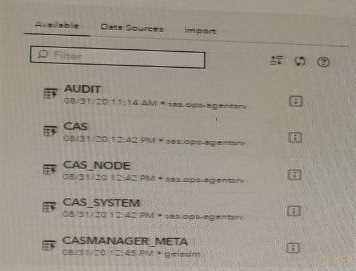
The operations infrastructure produces metric and log data in what form?
- A. XLS files
- B. CAS tables
- C. TSV files
- D. SAS tables
Answer:
C
Explanation:
The operations infrastructure produces metric and log data in the form of TSV files. TSV stands for
Tab Separated Values and is a file format used to store tabular data, such as data from a metrics and
logging system. The data is stored in plain text format, with each column separated by a tab
character. TSV files are typically used for data exchange between different applications, and are easily
readable by humans.
Question 7
The appender of a logging entity controls which aspect of the configuration for the SAS logging
facility?
- A. the output destination of the log message
- B. the log event categories to be included in the log
- C. the SAS Viya Server to which the logging configuration applies
- D. the default threshold level of the log message
Answer:
A
Explanation:
Reference: "Appenders define the output destinations for log messages. Each appender is associated
with a specific logging entity and controls where log messages for that entity are sent."
Question 8
Which statement is TRUE about modifying CAS server logging in SAS Environment Manager as it
compares to using the CAS server's logging configuration file?
- A. It is possible for a single-machine CAS server architecture only
- B. It requires a restart of the CAS server
- C. It only applies to CAS sessions for the user who makes the logging changes
- D. It is temporary and will only remain in effect until you restart the CAS server
Answer:
B
Explanation:
Modifying CAS server logging in SAS Environment Manager requires a restart of the CAS server in
order for the changes to take effect. It does not matter if you are using a single-machine CAS server
architecture or a distributed one. The changes will apply to all CAS sessions and will remain in effect
until you restart the CAS server.
Question 9
HOTSPOT
(**Note: This is an interactive item Follow the instructions to answer the question Scroll bars may
appear if the window is too small You may click anywhere on the exhibit Your answer choice will be
marked with a plus sign (+). You can relocate the plus sign to change your answer.)
Click the function on the SAS Environment Manager application menu you would use to check the
status of users' running CAS sessions?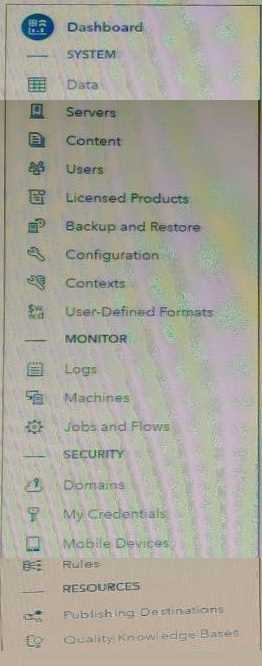
Answer:
None
Explanation:
Question 10
Refer to the exhibit (inverted color option of exhibit is available, if needed by clicking the tab):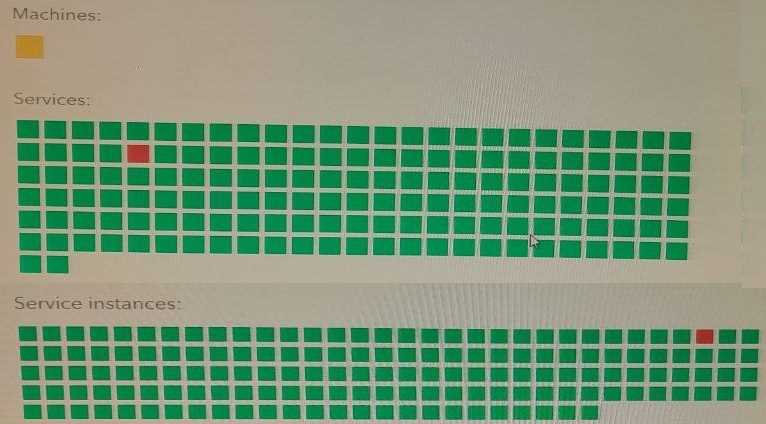
What does this dashboard indicate about the availability of the environment?
- A. The one machine in the environment is unavailable. A specific service on that machine and a related service instance are partially unavailable or in a warning state.
- B. One of several machines in the environment is partially unavailable or in a warning state. A service on another machine and unrelated service instance are unavailable
- C. The one machine in the environment is partially unavailable or in a warning state. A specific service on that machine and unrelated service instance are unavailable
- D. The one machine in the environment is partially unavailable or in a warning state. A specific service on that machine and a related service instance are unavailable
Answer:
D
Question 11
Which rule is the most permissive?
A)
B)
C)
D)
- A. Option A
- B. Option B
- C. Option C
- D. Option D
Answer:
C
Question 12
HOTSPOT
(**Note: This is an interactive item follow the instructions to answer the question Scroll bars may
appear if the window is too small You may click anywhere on the exhibit Your answer choice will be
marked with 0 plus sign (+). You can relocate the plus sign to change your answer.)
Click on the row of the identity that is not known to the Identities microservice.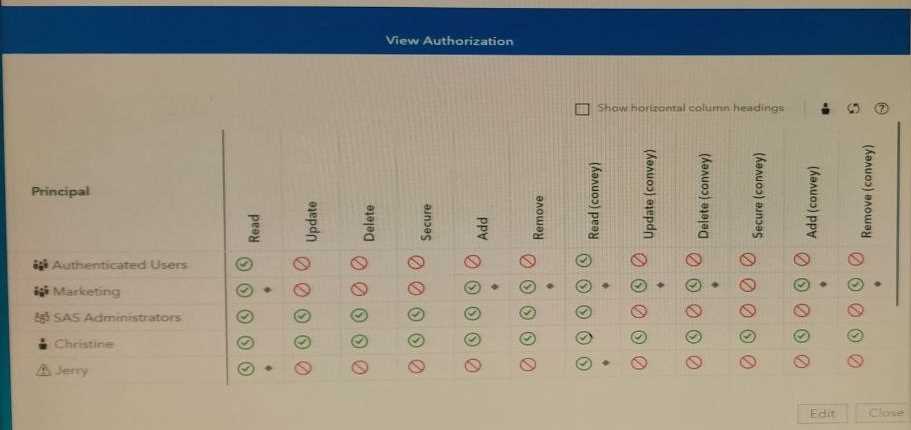
Answer:
None
Explanation: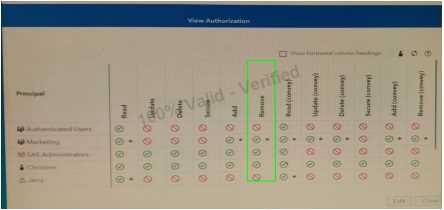
Question 13
In which authorization system does an explicit prohibit have absolute precedence?
- A. General authorization
- B. Metadata authorization
- C. CAS authorization
- D. Access authorization
Answer:
B
Explanation:
In the metadata authorization system, an explicit prohibit has absolute precedence. This means that
if a user or group is explicitly denied access to an object or resource, they will not be able to access it
regardless of any other permissions or authorizations that may be in place. This is different from
other authorization systems, such as CAS or access authorization, where other permissions may be
taken into account when determining a user's access level.
In metadata authorization, an explicit prohibit has absolute precedence, meaning it takes precedence
over any other type of authorization and can't be overridden. This is not the case in other
authorization systems such as general authorization, CAS authorization, and access authorization.
Question 14
Which type of SAS 9 content CANNOT be promoted to SAS Viya?
- A. OLAP cubes
- B. Folders
- C. User groups
- D. Data libraries and tables
Answer:
A
Explanation:
User groups cannot be promoted to SAS Viya when promoting content from SAS 9. This is because
SAS Viya uses a different authentication model than SAS 9 and so user groups need to be manually
recreated in Viya. As for the other types of SAS 9 content, OLAP cubes, folders, and data libraries and
tables can all be promoted to SAS Viya.
Question 15
When promoting content from SAS 9 to SAS Viya, what is the correct order of tasks after you've
created an initial map of system information?
- A. promote content, promote data definitions promote internal groups
- B. promote data definitions, promote internal groups, promote content
- C. promote content, promote internal groups, promote data definitions
- D. promote internal groups, promote data definitions, promote content
Answer:
C
Explanation:
When promoting content from SAS 9 to SAS Viya, the correct order of tasks after you've created an
initial map of system information is to promote content, promote internal groups, and then promote
data definitions. Content promotion involves copying SAS 9 content into Viya, while the promotion of
internal groups and data definitions involves creating Viya roles and data objects.